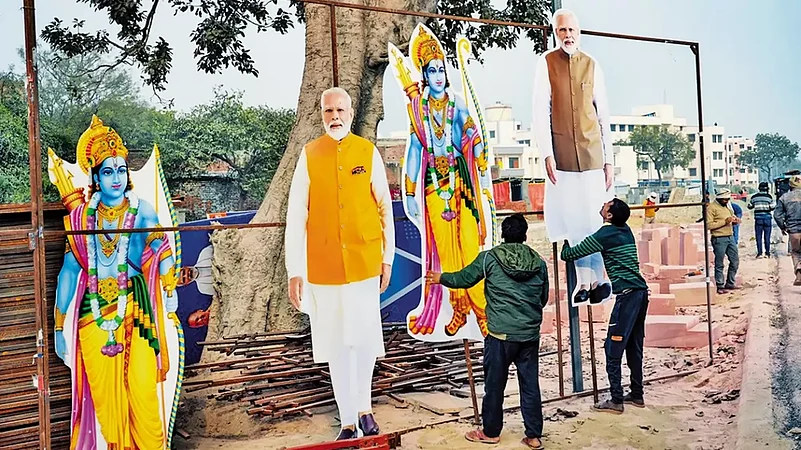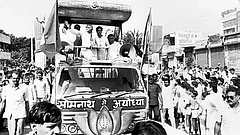Fifty-year-old Mohammad Shahid’s jaw clenched and unclenched as he watched a young man put up lights on the bare boundary wall of his home in Ayodhya’s Tedhibazar, ahead of the grand opening of the Ram temple. The lights are mandatory, he has been told.
He cannot help but think of that day, over 31 years ago, when the house, located just two kilometres from where the Babri Masjid then stood, had been similarly decked up with lights. It was his sister’s wedding in a few days. But the festivities ended in horror on December 6, 1992, after the illegal demolition of the Mughal-era mosque when Hindu mobs rampaged through Ayodhya, killing Muslims and setting fire to homes, including his.
Shahid’s grandfather Abdul Gaffar Khan was the last Imam of the Babri Masjid. He died in 1990. “It is good that he did not live to see that day,” Shahid states glumly. His father and his uncle (the Imam’s sons) were among the 17 people killed that day.
The charred remains of an aara (sawing machine) gathering dust in his derelict yard are the only physical proof the family keeps of the violence. “There used to be a wood workshop here where my father worked along with preaching at the mosque across the street. He was in the workshop when we got news that they were burning pages of the Quran. We knew we had to run,” he recalls.

While the rest of the family, including Shahid’s deceased mother Taibunnisa Begum, managed to escape to their neighbour Haji Mehboob’s house, his father and uncle got separated. The mob found them eventually, stabbed and burnt them alive in different locations. The wood workshop was reduced to cinders and rioters looted all they could from the house, including wedding gifts for his sister.
Eventually, Shahid made ends meet by driving a rickety auto-rickshaw, which helped him get his sister married in 1993. He proudly declares that his daughter is about to clear medical school. His two brothers are settled in other places. For the most part, Shahid has moved on from the tragedy.
The fresh surge of repeated volleys of “Jai Shree Ram” outside his house, which is on the road that leads to the new temple entrance, has nevertheless left Shahid wary. “We have borne our losses with dignity and have no problem with the temple being built. We respect the Supreme Court’s decision. But what about the killers of my father? Why was no justice ever done to victims of Babri demolition violence?” he asks.
“We have no problem with the temple being built. We respect the Supreme Court’s decision. But what about the killers of my father? Why was no justice ever done to victims of Babri demolition violence?”
With the day of the “Pran Pratishtha” looming closer, the nearly five lakh-strong Muslim population of Ayodhya is on tenterhooks. “The memories of bloodshed, arson and loot are too strong. People are getting emotional and some are even temporarily leaving to visit their relatives or do Umrah,” says Mohd Irfan ‘Nannebhai’, a local businessman and benefactor and an eyewitness to the violence of 1992. “We lost everything, friends, family members. And even those who survived had to bear heavy loss of property and livelihood”.

Banquo’s Ghost
About five kilometres away from Tedhibazar, Karsevakpuram bustles with tourists. The eight acre plot housing the Vishwa Hindu Parishad (VHP) headquarters, along with a makeshift temple, school and gaushala (cow shed), was used by kar sevaks as a hideout in 1990 when thousands arrived in response to a VHP call to demolish the contentious Babri mosque on October 30.
Veteran journalist and Faizabad resident Triyug Narayan Tripathi, who was working as a stringer for a national Hindi newspaper at the time, recalls the kar sevaks came at the behest of LK Advani and Ashok Singhal and were wearing chalk on their face which was said to fend off tear gas. The day was dubbed the “D-Day of kar seva” and the aim was to demolish the masjid. The mob, he claims, was out of control and managed to hoist saffron flags on the Babri before the police under the Mulayam Singh government opened fire on the kar sevaks, killing several. While state records show at least 50 were killed in the firing, Tripathi says that the number of casualties cannot be more than 16.
In 1992, when the BJP’s Kalyan Singh was chief minister of UP, the kar sevaks arrived in Ayodhya again, and this time, the police response was diametrically opposite. Preparations for the attack on Babri had started from December 3 onwards when the kar sevaks were given arms and training on how to break domes fast. “The mosque came down in just about five hours,” Tripathi recalls. While several leaders, including those of the BJP and the VHP, later claimed that the ensuing violence was the result of the crowd going out of control, Tripathi recalls that the kar sevaks had started to mark the houses of Muslims in the vicinity of Babri from December 3 itself. “My report about the potential fate of Babri was published on the front page of a newspaper on December 4. I had predicted the demolition. But the police took no note,” he states.

At least 250 homes were gutted in the December 6 violence and at least 17 were killed while several others went missing. While the victims were given some compensation for loss and damage, and those who lost their kin received a meagre Rs 2 lakh each, no investigation was made into the alleged murders.
With tourists and devotees pouring into Ayodhya, Karsevakpuram has become a big stop for tour guides on the state tourism department’s payroll who narrate the tale of the demolition with pride, projecting it as the first step that cleared the way for the construction of the Ram temple.
The place consists of a shrine dedicated to kar sevaks who were killed in the 1990 shootings, and other leaders and Sangh ideologues who played key roles in the demolition. It is also doubling, at present, as a warehouse for the stones that are being used in the construction of the new temple. Far from the humble bricks that the kar sevaks had collected over the years, these intricately engraved stones look like props of a film set, waiting for their turn backstage.
Fading Tehzeeb
Some of old Ayodhya’s residents watch these developments with growing unease.
Daddan Shashtri, a Ramkot resident, recalls how his classmate and friend Ishrat was killed by the mob. “He was a very sweet boy. We sometimes used to share our tiffin. He would have had a bright future if he had lived,” Shashtri recalls with a smile. He is a frequent visitor at Irfan’s house, which is a hub for locals—both Hindu and Muslim—to gather and discuss neighbourhood issues or just chit-chat in the cold while a fire crackles in his hearth.
“Ayodhya has always been a place of tolerance and intermingling of faiths. It has been an important centre of not just religion but also trade, crafts and culture,” he states. While Hindus call it “Ram Nagari,” the city has another moniker—“Sheher-e-Paighambar”, and is just as holy to Muslims as it is to Hindus.
The mazaar (tomb) of Hazrat Sheesh Alaihissalam, believed to be the son of Hazrat Aadam, the first person on Earth, is located in Ayodhya. His 600-year-old grave has been mentioned in the records of Abul Fazl, the historian of Emperor Akbar. The Navghazi Mazaar, located just behind the Ayodhya Police Station, is yet another one of the scores of significant religious spots for Muslims in the Ayodhya-Faizabad area that have hitherto received the patronage of both Muslim and Hindu devotees, giving it yet another name among locals—“Choti Mecca”.
Inside the fortress temple of Hanumangarhi, one of the oldest temple complexes of Ayodhya (incidentally built on a land grant from the Muslim Nawab Shuja-ud-dhaula on condition that reading of namaz would be allowed to continue on the land), lives Baba Gyan Das. The mahant has historically been a critic of Advani’s Rath Yatra and the politicisation of the Ram Janmabhoomi movement.
“We Welcome The Development. We Have Faith In Yogi Adityanath’s Strict Administration. But A Very Large Crowd Is Expected To Come Here And Crowds Can Get Wild, As We Have Seen In The Past.”
In 2016, he helped with the repair work of the Alamgiri Mosque, which lies on land owned by the Hanumangarhi temple trust and which had at that time been declared hazardous. “Ayodhya is the land of spiritualism and everyone is welcome to find their gods here. Ram was always in Ayodhya even before courts or politicians put him here. The presence of mosques does not change that,” the ascetic says. He also says that both Hindus and Muslims have left their imprints on these lands that cannot and should not be removed.
Over the past few years, however, Muslim organisations and residents of the area feel that their heritage and even their physical presence are being pushed to the peripheries. Aazam Qadri, the President of Anjuman Muhafiz Masajid wa Makabir, a local committee formed to save Waqf properties in Ayodhya, says that while the community is happy about the construction of the Ram temple, there is concern about the neglect and illegal usurping of important religious spots for Muslims, including masjids, bazaars, dargarhs, madrasas and graveyards. “In the past few months, several attempts have been made to illegally sell, purchase or usurp Wafq properties like masjids, dargahs, graveyards,” he states. Last September, Badr Mosque was illegally sold to the Ram Janmbahoomi Trust by persons who posed to be caretakers of the mosque. Qadri has raised the matter with district authorities and demanded an enquiry but nothing has happened so far.
“We feel that there is a conspiracy to push Muslims outside of Ayodhya,” Qadri alleges.
No Choice
About 25 kms away from Ayodhya centre, the five acres of land allotted to the Muslim litigants in the Babri-Ram Janmabhoomi dispute remains deserted. It is said the new Masjid Mohammad Bin Abdullah mosque will be the biggest in India and the premises would include a library, a medical college, a common veg kitchen for community service, and a cancer hospital that would treat all for free, among other proposed structures. “We are in talks with the government to increase the allotted area to 11 acres as five acres is not enough to accommodate all these buildings,” Qadri says.
Last year, Maharashtra BJP leader Haji Arafat Shaikh, who has been made chairman of the Masjid development committee, had claimed the new mosque would outshine the Taj Mahal. Nearly five years since the SC verdict, however, not a single brick has been laid at the spot. Authorities in charge, including Mumbai’s Zufar Ahmed Farooqui, President of the Indo Islamic Trust formed in 2020 and initially tasked with the construction of the mosque complex, state that construction is expected to begin this year.
Locals living in the vicinity of the allotted land in the Muslim-majority Dhannipur area are not as optimistic. Many like 57-year-old Mammu Khan feel that the government does not really intend to build the mosque. “We have not seen any official come here for over a year now. They didn’t even show up for the flag hoisting ceremony held on Independence Day at the old dargah, which stands on the allotted land,” he states. The valuation of Khan’s property has nevertheless gone up because of the mosque for which he remains thankful. “Just like in Ayodhya, we also want development here. We also want wider roads and more amenities. But the government is currently busy with Ram Mandir,” he says.
In what seems to be an attempt to project a secular image, the Ram Mandir Trust has sent an invite to attend the ceremony to Iqbal Ansari, son of Hashim Ansari, the oldest litigant in the Babri Masjid-Ram Janmabhoomi case. He died in 2016. His son tells Outlook that he is happy. “There is no difference between Hindus and Muslims here and we all are all part of Ayodhya. We all want Ram temple and the invite is proof of the Ganga Jamuni tehzeeb of the city,” Ansari narrates in what appears to be a rehearsed speech. Just a few kilometres from Ansari’s house lies the vacant home of Haji Mahmood, another prominent litigant. His family decided to travel to Medina and will only return once the consecration is over.
Residents claim that the government needs to safeguard the “life, properties and dignity” of Muslims living in Ayodhya. “We all welcome the development of the town. We have faith in Yogi Adityanath’s strict administration and Prime Minister’s promise of ‘sabka sath sabka vikas’. But a very large crowd is expected to come here on January 22 and crowds can get wild, as we have seen in the past,” says Mohd Shahid. When asked if he minds the lights the city administration is putting on his house, the grandson of the last Imam of Babri shrugs. “In the past, Hindus and Muslims in Ayodhya have happily celebrated many events together. But this time, we do not seem to have a choice.”
MORE FROM THIS ISSUE
(This appeared in the print as 'Sheher-e-Paighambar')































